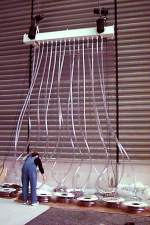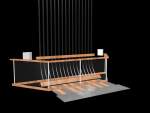|
The
Art Of
Motion Control
|
Pipedream I:
In the summer of 1999, the Science Museum of Minnesota was preparing to move from its long-standing home in St. Paul's downtown, to a new, much larger building built on a bluff overlooking the Mississippi River, a few blocks away. As part of this project, the Museum was seeking proposals for artworks that could be installed in the enormous public lobby space, where visitors first enter the building. Although there were only a few limitations imposed, they included the desire for kinetic and interactive work, and the stipulation that minimal floor space could be used -- either wall mounted or hanging structures only.
I set to work feverishly trying to come up with an idea, hoping to in some way make Sisyphus (the sand plotter) work... dead end. While sharing my frustration with my wife, she suggested "why not try water?" I shot back that the idea of trying an entirely new medium, given so little time, did not strike me as a viable option. Then she said "what about bubbles?" As soon as I heard the word, I recalled an idea from years earlier (2/18/94, according to my lab notebook) that boils down to the basic idea of using rising bubbles in parallel tubes as a kind of raster display.
I quickly put together a small, 8-tube maquette, videotaped patterns and crude alphanumeric characters composed of bubbles, and handed in my proposal-- which was accepted. As this was my first large-scale commission with a large institution I learned a great deal throughout the ensuing months, leading up to the Museum's opening on December 12, 1999.
Perhaps the hardest lesson, involved the interactive component of the sculpture. Using my CNC plasma cutting rig, I cut a giant piano keyboard out of aluminum and copper plate, and created what I thought would be an ideal input device. Unfortunately, I also created the world's best incentive for getting kids to jump up and down! The noise and vibration interfered with both the sanity of people in offices one floor down, as well as the operation of the Omni theater, housed behind the vertical wall. After about a month, I removed the keyboard.
Since then, it has been bubbling steadily, requiring only some early maintenance tweaks. Bubble patterns include simple geometric shapes (e.g.. diamonds) and a smiley face. I also have had the opportunity to do a custom pattern and text display for a wedding!
Some shots of Pipedream I's development:

Hanging and stretching the tubes.
